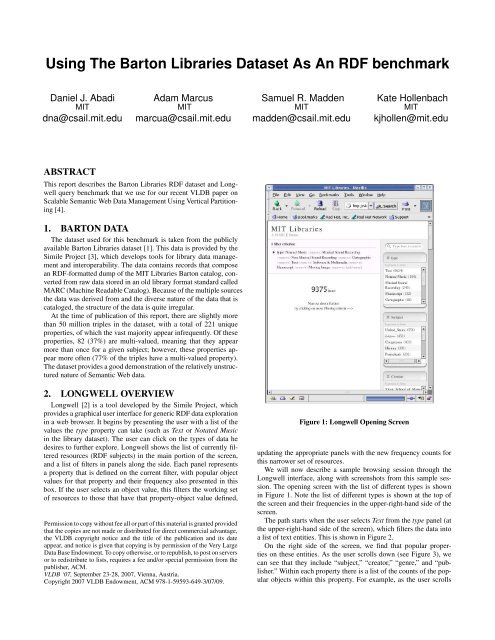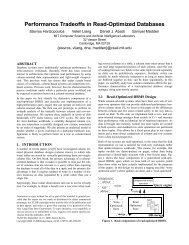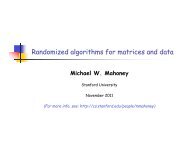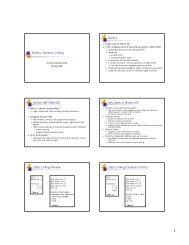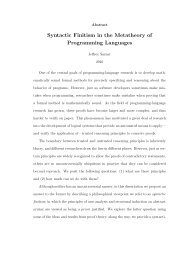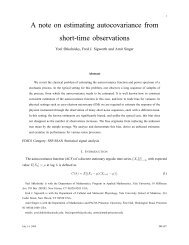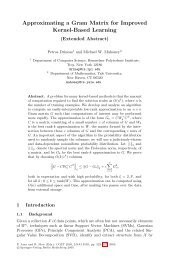Using The Barton Libraries Dataset As An RDF benchmark
Using The Barton Libraries Dataset As An RDF benchmark
Using The Barton Libraries Dataset As An RDF benchmark
Create successful ePaper yourself
Turn your PDF publications into a flip-book with our unique Google optimized e-Paper software.
<strong>Using</strong> <strong>The</strong> <strong>Barton</strong> <strong>Libraries</strong> <strong>Dataset</strong> <strong>As</strong> <strong>An</strong> <strong>RDF</strong> <strong>benchmark</strong><br />
Daniel J. Abadi<br />
MIT<br />
dna@csail.mit.edu<br />
ABSTRACT<br />
Adam Marcus<br />
MIT<br />
marcua@csail.mit.edu<br />
This report describes the <strong>Barton</strong> <strong>Libraries</strong> <strong>RDF</strong> dataset and Longwell<br />
query <strong>benchmark</strong> that we use for our recent VLDB paper on<br />
Scalable Semantic Web Data Management <strong>Using</strong> Vertical Partitioning<br />
[4].<br />
1. BARTON DATA<br />
<strong>The</strong> dataset used for this <strong>benchmark</strong> is taken from the publicly<br />
available <strong>Barton</strong> <strong>Libraries</strong> dataset [1]. This data is provided by the<br />
Simile Project [3], which develops tools for library data management<br />
and interoperability. <strong>The</strong> data contains records that compose<br />
an <strong>RDF</strong>-formatted dump of the MIT <strong>Libraries</strong> <strong>Barton</strong> catalog, converted<br />
from raw data stored in an old library format standard called<br />
MARC (Machine Readable Catalog). Because of the multiple sources<br />
the data was derived from and the diverse nature of the data that is<br />
cataloged, the structure of the data is quite irregular.<br />
At the time of publication of this report, there are slightly more<br />
than 50 million triples in the dataset, with a total of 221 unique<br />
properties, of which the vast majority appear infrequently. Of these<br />
properties, 82 (37%) are multi-valued, meaning that they appear<br />
more than once for a given subject; however, these properties appear<br />
more often (77% of the triples have a multi-valued property).<br />
<strong>The</strong> dataset provides a good demonstration of the relatively unstructured<br />
nature of Semantic Web data.<br />
2. LONGWELL OVERVIEW<br />
Longwell [2] is a tool developed by the Simile Project, which<br />
provides a graphical user interface for generic <strong>RDF</strong> data exploration<br />
in a web browser. It begins by presenting the user with a list of the<br />
values the type property can take (such as Text or Notated Music<br />
in the library dataset). <strong>The</strong> user can click on the types of data he<br />
desires to further explore. Longwell shows the list of currently filtered<br />
resources (<strong>RDF</strong> subjects) in the main portion of the screen,<br />
and a list of filters in panels along the side. Each panel represents<br />
a property that is defined on the current filter, with popular object<br />
values for that property and their frequency also presented in this<br />
box. If the user selects an object value, this filters the working set<br />
of resources to those that have that property-object value defined,<br />
Permission to copy without fee all or part of this material is granted provided<br />
that the copies are not made or distributed for direct commercial advantage,<br />
the VLDB copyright notice and the title of the publication and its date<br />
appear, and notice is given that copying is by permission of the Very Large<br />
Data Base Endowment. To copy otherwise, or to republish, to post on servers<br />
or to redistribute to lists, requires a fee and/or special permission from the<br />
publisher, ACM.<br />
VLDB ‘07, September 23-28, 2007, Vienna, Austria.<br />
Copyright 2007 VLDB Endowment, ACM 978-1-59593-649-3/07/09.<br />
Samuel R. Madden<br />
MIT<br />
madden@csail.mit.edu<br />
Figure 1: Longwell Opening Screen<br />
Kate Hollenbach<br />
MIT<br />
kjhollen@mit.edu<br />
updating the appropriate panels with the new frequency counts for<br />
this narrower set of resources.<br />
We will now describe a sample browsing session through the<br />
Longwell interface, along with screenshots from this sample session.<br />
<strong>The</strong> opening screen with the list of different types is shown<br />
in Figure 1. Note the list of different types is shown at the top of<br />
the screen and their frequencies in the upper-right-hand side of the<br />
screen.<br />
<strong>The</strong> path starts when the user selects Text from the type panel (at<br />
the upper-right-hand side of the screen), which filters the data into<br />
a list of text entities. This is shown in Figure 2.<br />
On the right side of the screen, we find that popular properties<br />
on these entities. <strong>As</strong> the user scrolls down (see Figure 3), we<br />
can see that they include “subject,” “creator,” “genre,” and “publisher.”<br />
Within each property there is a list of the counts of the popular<br />
objects within this property. For example, as the user scrolls
Figure 2: Longwell Screen Shot After Clicking on “Text” in the<br />
Type Property Panel<br />
down even more (see Figure 4), we find out that the German object<br />
value appears 122 times and the French object value appears 131<br />
times under the language property. By clicking on “fre” (French<br />
language), information about the 131 French texts in the database<br />
is presented, along with the revised set of popular properties and<br />
property values defined on these French texts. This is shown in Figure<br />
5.<br />
Currently, Longwell only runs on a small fraction of the <strong>Barton</strong><br />
data – 9375 records, as its <strong>RDF</strong> triple store cannot scale to support<br />
the full 50 million triple dataset while still allowing interactive response<br />
time to queries (we show this scalability limitation in our<br />
paper [4]).<br />
3. LONGWELL QUERIES<br />
<strong>The</strong> <strong>benchmark</strong> features seven queries that need to be executed<br />
on a typical Longwell path through the data. <strong>The</strong>se queries are<br />
based on a typical browsing session, where the user selects a few<br />
specific entities to focus on and where the aggregate results summarizing<br />
the contents of the <strong>RDF</strong> store are updated.<br />
<strong>The</strong> full queries are described at a high level here and are provided<br />
in full in the next section as SQL queries against a triple store.<br />
Query 1 (Q1). Calculate the opening panel displaying the counts of<br />
the different types of data in the <strong>RDF</strong> store. This requires a search<br />
for the objects and counts of those objects with property Type.<br />
<strong>The</strong>re are 30 such objects. For example: Type: Text has a count of<br />
1, 542, 280, and Type: NotatedMusic has a count of 36, 441.<br />
Query 2 (Q2). <strong>The</strong> user selects Type: Text from the previous panel.<br />
Figure 3: Longwell Screen Shot After Clicking on “Text” in the<br />
Type Property Panel and Scrolling Down<br />
Longwell must present him with a list of other defined properties<br />
for resources of Type: Text. It must also calculate the frequency<br />
of these properties. For example, the Language property is defined<br />
1, 028, 826 times for resources that are of Type: Text.<br />
Query 3 (Q3). For each property defined on items of Type: Text,<br />
populate the property panel with the counts of popular object values<br />
for that property (where popular means that an object value appears<br />
more than once). For example, the property Edition has 8 items with<br />
value “[1st ed. reprinted].”<br />
Query 4 (Q4). This query recalculates all of the property-object<br />
counts from Q3 if the user clicks on the “French” value in the “Language”<br />
property panel. Essentially this is narrowing the working set<br />
of subjects to those whose Type is Text and Language is French.<br />
This query has a much higher-selectivity than Q3.<br />
Query 5 (Q5). Here we perform a type of inference. If there are<br />
triples of the form (X Records Y) and (Y Type Z) then we can infer<br />
that X is of type Z. Here X Records Y means that X records<br />
information about Y (for example, X might be a web page with information<br />
on Y). For this query, we want to find the inferred type of<br />
all subjects that have this Records property defined that also originated<br />
in the US Library of Congress (i.e. contain triples of the form<br />
(X origin “DLC”)). <strong>The</strong> subject and inferred type is returned for all<br />
non-Text entities.<br />
Query 6 (Q6). For this query, we combine the inference first step<br />
of Q5 with the property frequency calculation of Q2 to extract information<br />
in aggregate about items that are either directly known to<br />
be of Type: Text (as in Q2) or inferred to be of Type: Text through<br />
the Q5 Records inference.
Figure 4: Longwell Screen Shot After Clicking on “Text” in the<br />
Type Property Panel and Scrolling Down to the Language Property<br />
Panel<br />
Query 7 (Q7). Finally, we include a simple triple selection query<br />
with no aggregation or inference. <strong>The</strong> user tries to learn what a<br />
particular property (in this case Point) actually means by selecting<br />
other properties that are defined along with a particular value of this<br />
property. <strong>The</strong> user wishes to retrieve subject, Encoding, and Type<br />
of all resources with a Point value of “end.” <strong>The</strong> result set indicates<br />
that all such resources are of the type Date. This explains why these<br />
resources can have “start” and “end” values: each of these resources<br />
represents a start or end date, depending on the value of Point.<br />
We make the assumption that an administrator has selected a set<br />
of 28 interesting properties over which queries will be run. <strong>The</strong>se<br />
properties are listed in Section 5. <strong>The</strong>re are 26761389 triples for<br />
these properties. For queries Q2, Q3, Q4, and Q6, only these 28<br />
properties are considered for aggregation.<br />
4. LONGWELL QUERIES IN SQL<br />
<strong>The</strong> queries below are the seven <strong>benchmark</strong> queries written in<br />
SQL against a triple store schema.<br />
<strong>The</strong> properties table listed in these queries contains the list of 28<br />
properties that are processed for queries 2, 3, 4, and 6.<br />
Query1:<br />
SELECT A.obj, count(*)<br />
FROM triples AS A<br />
WHERE A.prop = ""<br />
GROUP BY A.obj<br />
Query2:<br />
SELECT B.prop, count(*)<br />
Figure 5: Longwell Screen Shot After Clicking on “fre” in the<br />
Language Property Panel<br />
FROM triples AS A, triples AS B,<br />
properties AS P<br />
WHERE A.subj = B.subj<br />
AND A.prop = ""<br />
AND A.obj = ""<br />
AND P.prop = B.prop<br />
GROUP BY B.prop<br />
Query3:<br />
SELECT B.prop, B.obj, count(*)<br />
FROM triples AS A, triples AS B,<br />
properties AS P<br />
WHERE A.subj = B.subj<br />
AND A.prop = ""<br />
AND A.obj = ""<br />
AND P.prop = B.prop<br />
GROUP BY B.prop, B.obj<br />
HAVING count(*) > 1<br />
Query4:<br />
SELECT B.prop, B.obj, count(*)<br />
FROM triples AS A, triples AS B,<br />
triples AS C, properties AS P<br />
WHERE A.subj = B.subj<br />
AND A.prop = ""<br />
AND A.obj = ""<br />
AND P.prop = B.prop<br />
AND C.subj = B.subj<br />
AND C.prop = ""<br />
AND C.obj =<br />
""<br />
GROUP BY B.prop, B.obj<br />
HAVING count(*) > 1<br />
Query5:<br />
SELECT B.subj, C.obj
FROM triples AS A, triples AS B,<br />
[4] D. J. Abadi, A. Marcus, S. Madden, and K. Hollenbach.<br />
triples AS C<br />
Scalable semantic web data management using vertical<br />
WHERE A.subj = B.subj<br />
AND A.prop = "" partitioning. In Proc. of VLDB, 2007.<br />
AND A.obj = ""<br />
AND B.prop = ""<br />
AND B.obj = C.subj<br />
AND C.prop = ""<br />
AND C.obj != ""<br />
Query6:<br />
SELECT A.prop, count(*)<br />
FROM triples AS A, properties AS P (<br />
(SELECT B.subj<br />
FROM triples AS B<br />
WHERE B.prop = ""<br />
AND B.obj = "")<br />
UNION<br />
(SELECT C.subj<br />
FROM triples AS C, triples AS D<br />
WHERE C.prop = ""<br />
AND C.obj = D.subject<br />
AND D.prop = ""<br />
AND D.obj = "")<br />
) AS uniontable<br />
WHERE A.subj = uniontable.subj<br />
AND P.prop = A.prop<br />
GROUP BY A.prop;<br />
Query7:<br />
SELECT A.subj, B.obj,<br />
C.obj<br />
FROM triples AS A, triples AS B,<br />
triples AS C<br />
WHERE A.prop = ""<br />
AND A.obj = ’"end"’<br />
AND A.subj = B.subject<br />
AND B.prop = ""<br />
AND A.subj = C.subject<br />
AND C.prop = "";<br />
5. PROPERTIES<br />
<strong>The</strong> 28 properties contained in the properties table are:<br />
<br />
<br />
<br />
<br />
<br />
<br />
<br />
<br />
<br />
<br />
<br />
<br />
<br />
<br />
<br />
<br />
<br />
<br />
<br />
<br />
<br />
<br />
<br />
<br />
<br />
<br />
<br />
<br />
6. REFERENCES<br />
[1] Library catalog data.<br />
http://simile.mit.edu/rdf-test-data/barton/.<br />
[2] Longwell website. http://simile.mit.edu/longwell/.<br />
[3] Simile website. http://simile.mit.edu/.


